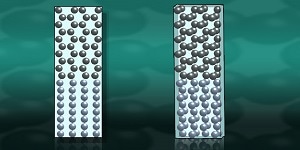Sep 15 2016
 Ten layers of hexagonal iron (dark gray) above eight layers of cubic iron (pale blue-gray). Each layer can transform from one structure to the other by pinching pairs of adjacent atoms toward or away from one another. Lawrence Livermore researchers calculated the structural transformation of iron, showing how it springs back to shape under pressure. (CREDIT: Lawrence Livermore National Laboratory)
Ten layers of hexagonal iron (dark gray) above eight layers of cubic iron (pale blue-gray). Each layer can transform from one structure to the other by pinching pairs of adjacent atoms toward or away from one another. Lawrence Livermore researchers calculated the structural transformation of iron, showing how it springs back to shape under pressure. (CREDIT: Lawrence Livermore National Laboratory)
Physicists from Lawrence Livermore National Laboratory (LLNL) have carried out a sequence of calculations that shed light on an unanticipated way in which iron changes under dynamic compression.
Published in Physical Review Letters, the teams paper explains first-principle calculations on two solid phases of iron, and also on intermediate crystal structures alongside the transformation path from one phase to the other.
The calculations include an accurately parameterized model for magnetic fluctuations (electron spin waves) including the effect of shifting the iron nuclei as squeezing of the material takes place in a shock experiment.
The scientists have played multiple roles in this specific issue that has been in existence for more than a decade. A Laboratory Directed Research and Development (LDRD) Strategic Initiative project, headed by Hector Lorenzana, executed ground-breaking shock experiments, including a few experiments on single crystal iron.
In these original shock experiments, a single crystal of iron transforms under compression and then springs back (for the most part) to the original, intact lattice. This unique, reversible behavior has defied understanding for years.
Michael Surh, Materials Scientist, LLNL
Large-scale molecular dynamics (MD) simulations at Los Alamos predicted this rapid, reversible transition even though the role of magnetism was not considered. More precise, first-principle, magnetic calculations executed for iron by LLNL's Babak Sadigh and Surh highlighted transformations that were much slower.
LLNL's Jonathan Crowhurst and another team at the lab carried out shock compression experiments, which pointed out that this transformation can go on for a longer time than that predicted by MD.
Putting this in perspective also helps to achieve the surprising element of the original experiment. Generally, a first order solid-solid structural transformation is irreversible and slow. The individual begins by squeezing a near-perfect, single crystal; it then randomly starts a structural transformation in remote regions.
These remote regions then grow together. This leads to the development of a polycrystalline new phase. The material remains polycrystalline if it is transformed back to the old phase. The original, single crystal is lost.
To make an analogy, the original, crystalline 3D lattice acts like a single cloth that transforms to some different weave, and is then stretched and torn into tiny patches that get rewoven and sewn in a random manner. When it comes back to the original weave, the random patches stay, and the whole, original cloth gets destroyed.
The transformation seems to be virtually seamless in the case of the single crystals of iron.
This reversible transformation is reminiscent of what happens in a shape-memory alloy. Such materials can change linear dimensions by almost 10 percent and then reversibly change back. It turns out that the different (fast versus slow, reversible versus irreversible) behavior seen in iron depends on its changing magnetism.
Michael Surh, Materials Scientist, LLNL
The researchers assume that if iron is compressed in a uniform manner in one direction, then the energy barrier dividing the different phases continues to be sizable even if thermally excited spin waves are added. This slows down the initial transformation process. This transformation front moves rapidly when the interface existing between two phases is developed, as if no barrier ever existed.
It is proven that this generates from "magnetic frustration," which is a competition present between the tendencies of electron spins to be either misaligned or aligned with those of their neighbors.
The predictions made by the team propose an explanation for the varied experiments carried out at LLNL. The team highlighted that magnetic effects must be included in future simulations in order to obtain a basic understanding of the interesting phenomenon.
The research was part of a LDRD project to improve the understanding of magnetism from initial principles.